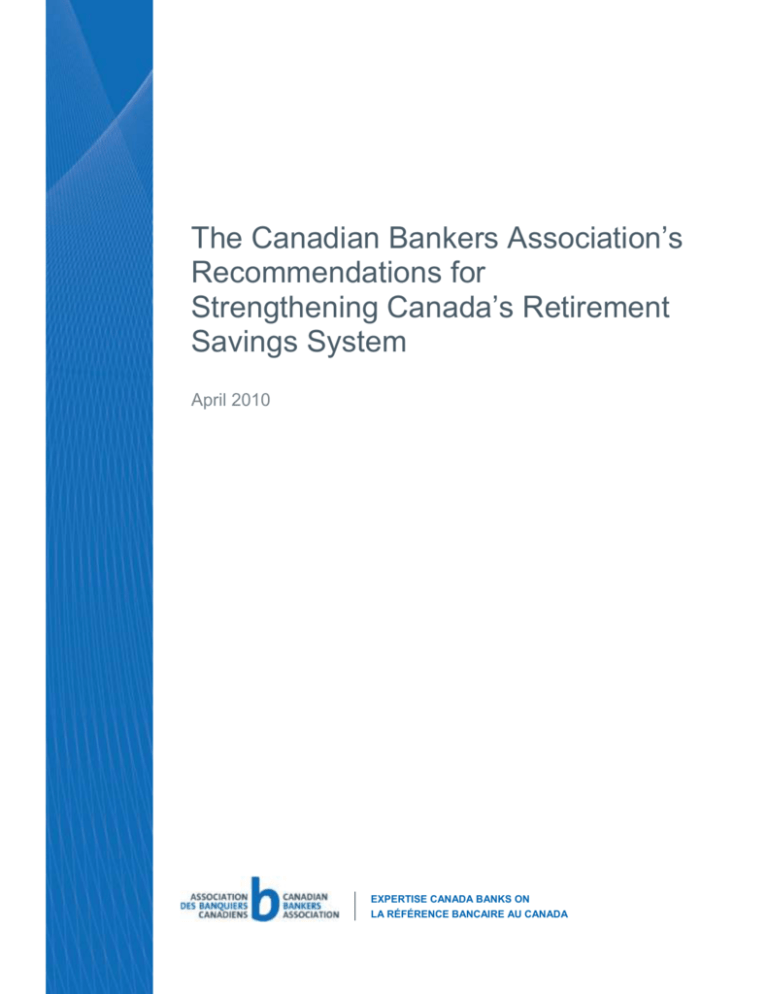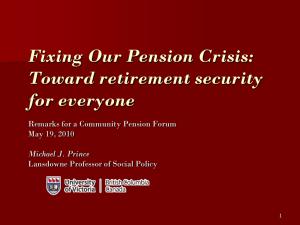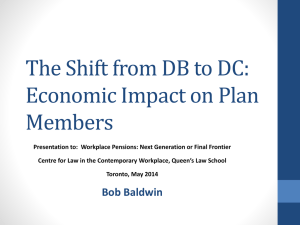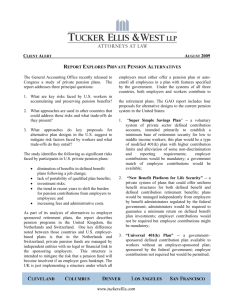The Canadian Bankers Association's Recommendations for
advertisement

The Canadian Bankers Association’s Recommendations for Strengthening Canada’s Retirement Savings System April 2010 EXPERTISE CANADA BANKS ON LA RÉFÉRENCE BANCAIRE AU CANADA In two reports – Modernizing Canada’s Retirement Savings System (November 2009) and Enhancing Canadians’ Savings Options (April 2010) – the Canadian Bankers Association provides the banking industry’s contributions to the public policy discussion on strengthening the pension and retirement savings system in Canada (reports can be found at www.cba.ca). Set out below is a summary of the CBA’s recommendations. The retirement savings system in Canada Canadian families save in many different ways depending on their individual circumstances, which evolve over the course of a family’s life-cycle. It is important, therefore, that policy makers not focus exclusively on pension or registered plan participation as the only measures of financial security. A “one-size-fits-all” approach would not be effective in addressing the actual savings needs of Canadians. Canada already has a strong and well-functioning retirement savings systems, but some necessary fixes to out-of-date and restrictive rules should be implemented to strengthen Canadians’ financial security. It would be more effective for governments to work together to improve the private-sector, tax-assisted system rather than create new public sector plans that duplicate the infrastructure already in place. Public policy in Canada should also focus on ensuring that Canadian families have the tools, skills, and financial literacy necessary to manage their financial security throughout their life cycle and into retirement. As a strong proponent of increased financial literacy, the banking industry supports the federal government’s efforts and is encouraging the Financial Literacy Task Force to ensure that retirement planning is a key element of its deliberations. The adequacy of retirement savings is a national issue, and requires national public policy solutions that will enhance the ability of individual Canadians to save. Fragmentation of policy and approaches across the country will ultimately hurt rather than help Canadians. Improving the pension plan system Harmonizing pension laws across the federal and provincial jurisdictions would remove barriers and unnecessary costs for companies operating in more than one province when considering offering pension plans to their employees. In this regard, we support the federal government’s proposed changes (in Bill C-9) to federal pension rules (particularly changes that would allow plan sponsors to build a large pension surplus to act as a “cushion” to help weather economic downturns), and encourage other governments in Canada to work with the federal government on harmonization. Further changes to pension laws, however, are needed to make pension plans more attractive and viable. In particular, the federal Pension Benefits Standards Act and its provincial counterparts should be amended to clarify that plan sponsors have ownership of and access to surplus funds including at windup unless the terms of the plan state otherwise. The right to offer pension plans should be de-linked from the employment relationship, through changes to the federal Income Tax Act rule which currently requires that pensions be based on income from an employer. This would allow for multi-employer, multi-sponsor or third party plans open to a wider range of membership (such as small/medium sized businesses and self-employed individuals). Such plans could lower costs because of economies of scale and increased competition. It is important that all qualified financial institutions be able to offer such plans on a level playing field basis. 1 Improving the ways that registered retirement savings are converted into income The age at which Registered Retirement Savings Plans (RRSPs) must be closed out (currently 71 years) should be increased, to provide Canadians with additional years to make contributions and will increase the future annual income that those savings can generate. The minimum rate at which funds must be withdrawn from Registered Retirement Income Funds (RRIFs) should be lowered to extend the life of RRIF assets. RRSP withdrawals should be taxed at more favourable rates to encourage greater use of RRSPs and increase after-tax income generated by those savings in retirement. Currently, RRSP withdrawals are treated as income for tax purposes, and do not benefit from the favourable treatment provided to dividend income or capital gains, even though that may have been the way those savings were generated. Canadians who have held their savings in a bank and who wish to convert those savings into a life annuity should have the ability to do so at a bank branch. Increasing the tax-assisted savings room for all Canadians Pension plan and income tax legislation in Canada should be amended to allow a lifetime approach to retirement savings for RRSPs, Tax Free Savings Accounts (TFSAs) and defined contribution pension plans, rather than the current annual contribution limit approach. A lifetime contribution approach would allow individuals to make up for a lack of savings in some years (e.g., because of fluctuating incomes or the need to leave the workforce temporarily for parental leave) by topping up savings in other years. Although RRSPs allow a carry-forward of unused contribution room, and withdrawals from a TFSA can be re-contributed, these plans would be more effective if they were structured on the basis of life-time rather than annual contributions. All workers should have the tax-assisted retirement savings room they need whether they work in the public or private sector and regardless of the type of plan (e.g., employer-sponsored plan, RRSP or multisponsor pension plan, defined contribution or defined benefit) and they should be able to make use of that room in the plan of their choice. Self-employed individuals and workers who do not have an employer-sponsored plan should be allowed to save substantially more through an RRSP, TFSA or other tax-assisted vehicles than they can currently. As the TFSA is a new product which will be of less cumulative value to older Canadians than younger ones, those born before some specified date could be granted additional TFSA room. Constructed this way, it would constitute a transition provision that would disappear over time. As their needs change, families may find that they should be saving in a different registered plan. Governments should consider ways to allow transfers between registered plans (e.g. from a Registered Education Savings Plan to a Registered Disability Savings Plan). 2








